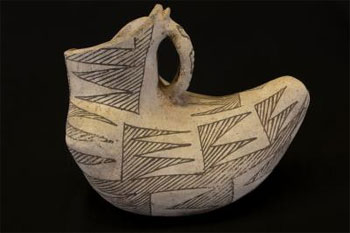 |
|||||||||||||||||||
|
|
|||||
 |
|||||||||||||||||||
|
|
|||||
|
|||||||||
|
![Diné [Navajo] Code Talkers Corporal Henry Bahe, Jr. and Private First Class George H. Kirk. Bougainville, South Pacific, December 1943](images/Museums/Museum%20of%20Indian%20Arts%20%26%20Culture/Birds-1_350.jpg) |
||||||||
 |
|
||||||||
|
 |
||||||||
 |
|
||||||||
|
The Museum of Indian Arts & Culture email: miac.info@state.nm.us www.indianartsandculture.org
HOURS ADMISSION TOURS Mission Vision Statement Our state-of-the-art-exhibits continue to excite and inspire people to learn more about Native cultures and the anthropology and archaeology of the Greater Southwest. We are viewed as a leader in our field resulting in increased recognition by international scholars, our funders, our stakeholders, accrediting agencies, and other museums. We strive to improve our facilities and increase access through the digitization of our collections and the development of the Center for New Mexico Archaeology. Docent Tours
Tours of the Museum of Indian Arts & Culture are an excellent introduction to the complexity and diversity of the Native American cultures of the Southwest. Free, walk-in docent-led tours of the museum's exhibitions are offered daily, usually at 10:30am, 12noon, and 2pm. Please call 476-1269 during museum hours to confirm tours offered each day, or 476-1250 after hours for recorded general museum information. Tour groups can also benefit from interaction with the museum's energetic and knowledgeable docents, who are trained to offer challenging, interactive tours of Here, Now & Always, The Buchsbaum Gallery of Southwestern Pottery, and the museum's regularly changing exhibits. Free docent-led tours are available to pre-registered groups of any age or interest.
Pre-registered school groups are admitted free to the museum and both docent-led and self-guided tours of our exhibitions provide opportunities for discussion, discovery, and inspiration. All schools participating in the free Living Traditions Education Program receive a guided tour along with their hands-on session in the museum's classroom. About More than 65,000 visitors come to the Museum of Indian Arts & Culture each year, of which 30% hail from New Mexico, 50% from other states, and 20% from foreign countries. It is MIAC's mission to provide cross-cultural education to the many visitors to Santa Fe who take part in our programs and to New Mexican residents throughout the state. It is especially important that MIAC serve the Indian communities in our state and throughout the Southwest whose contemporary and ancestral cultures are represented in the museum's collections. History of the Laboratory of Anthropology and the Museum of Indian Arts & Culture As the 19th century came to a close, the American Southwest was undergoing enormous transition.Sculpture garden Tourists from Europe and the East Coast of America flooded the area, drawn by word-of-mouth from early visitors and quick to take advantage of the railroad, which had just arrived in the West. One of the Southwest's major "attractions" was its vibrant Native American cultures. In response to unsystematic collecting by Eastern museums, anthropologist Edgar Lee Hewett founded the Museum of New Mexico in 1909 with a mission to collect and preserve Southwest Native American material culture. Several years later, in 1927, John D. Rockefeller founded the renowned Laboratory of Anthropology with a mission to study the Southwest's indigenous cultures. In 1947 the two institutions merged, bringing together the most inclusive and systematically acquired collection of New Mexican and Southwestern anthropological artifacts in the country. The Laboratory's collection continued to expand but was largely unavailable to the general public for lack of adequate exhibition facilities. In 1977, the New Mexico legislature appropriated $2.7 million for the design of a new Museum of Indian Arts & Culture. The MIAC opened ten years later in 1987, immediately adjacent to the Laboratory, as the 31,000 square foot exhibition facility for the Lab's extensive collections. In the following years, planning began for additional exhibition and collections storage space in the 21,000 square foot Amy Rose Bloch Wing and the revolutionary new exhibition Here, Now & Always, which opened in August, 1997. This groundbreaking permanent exhibition, developed by a core curatorial team composed of Southwest Indian peoples and museum professionals, incorporates the voices of more than 75 Native Americans. Here, Now & Always tells the rich, complex and diverse stories of Native Americans in the Southwest through their own words and some 1,300 objects drawn from the Museum's collections. This expansion continues in the new Living Traditions Educational Center, a multifaceted education complex providing additional exhibition space, multi-purpose event center, a classroom, hands-on center, Docent Library, Resource Center, and Museum Studies Center. Birds: Spiritual Messengers of the Skies Collecting Jewelry: Curator H.P. Mera’s Trip to Navajo Country in 1932 |
|||||||||
| Exhibition Information page 2 |
|
||||||||
| Support Your Local Galleries and Museums! They Are Economic Engines for Your Community. | |||||||||
| ADVERTISE ON THIS SITE | HOME | EXHIBITIONS | INDEX | EVENTS | ABOUT US | LINKS | CONTACT US | DONATE | SUBSCRIBE |
| Copyright 2011 Art Museum Touring.com |